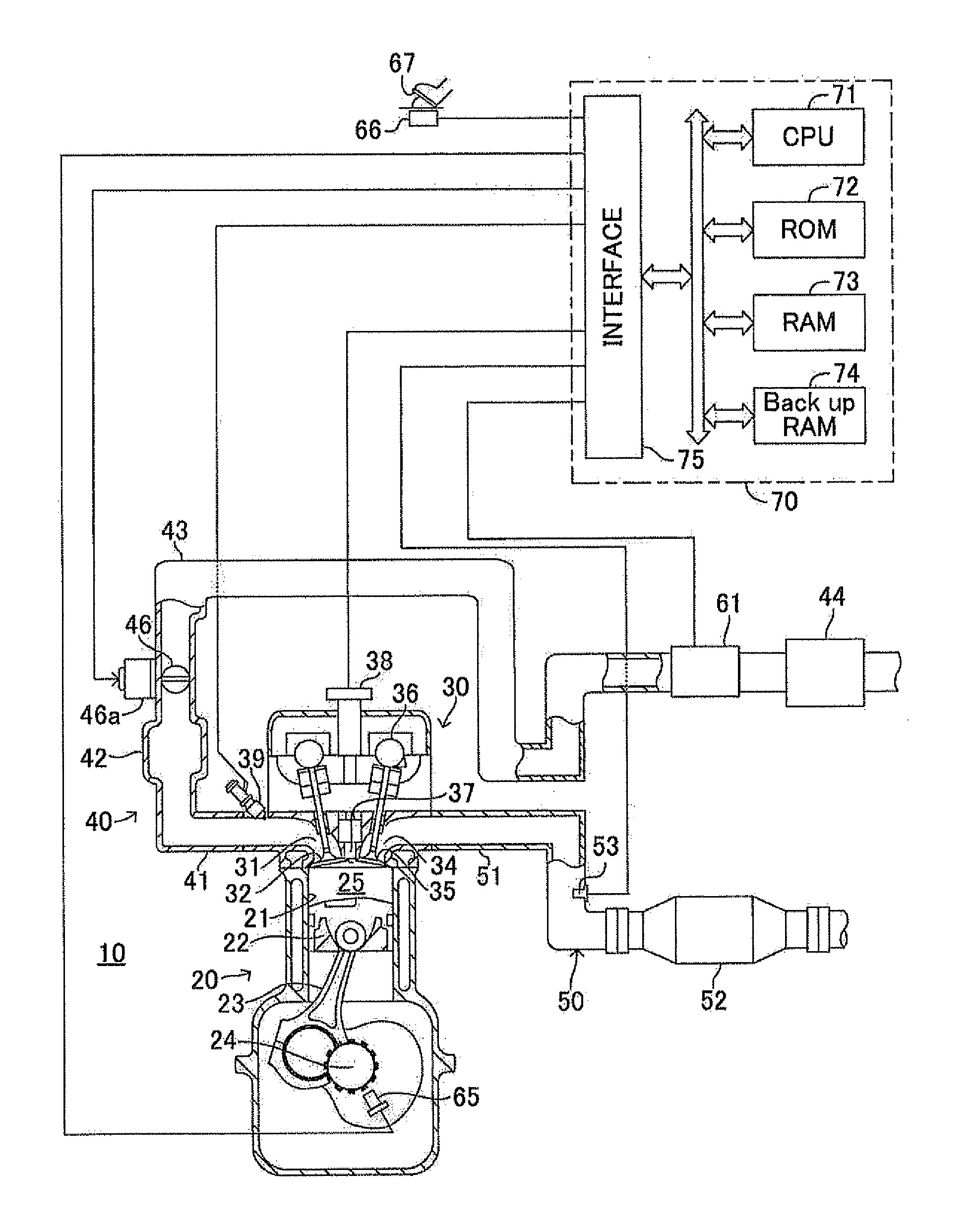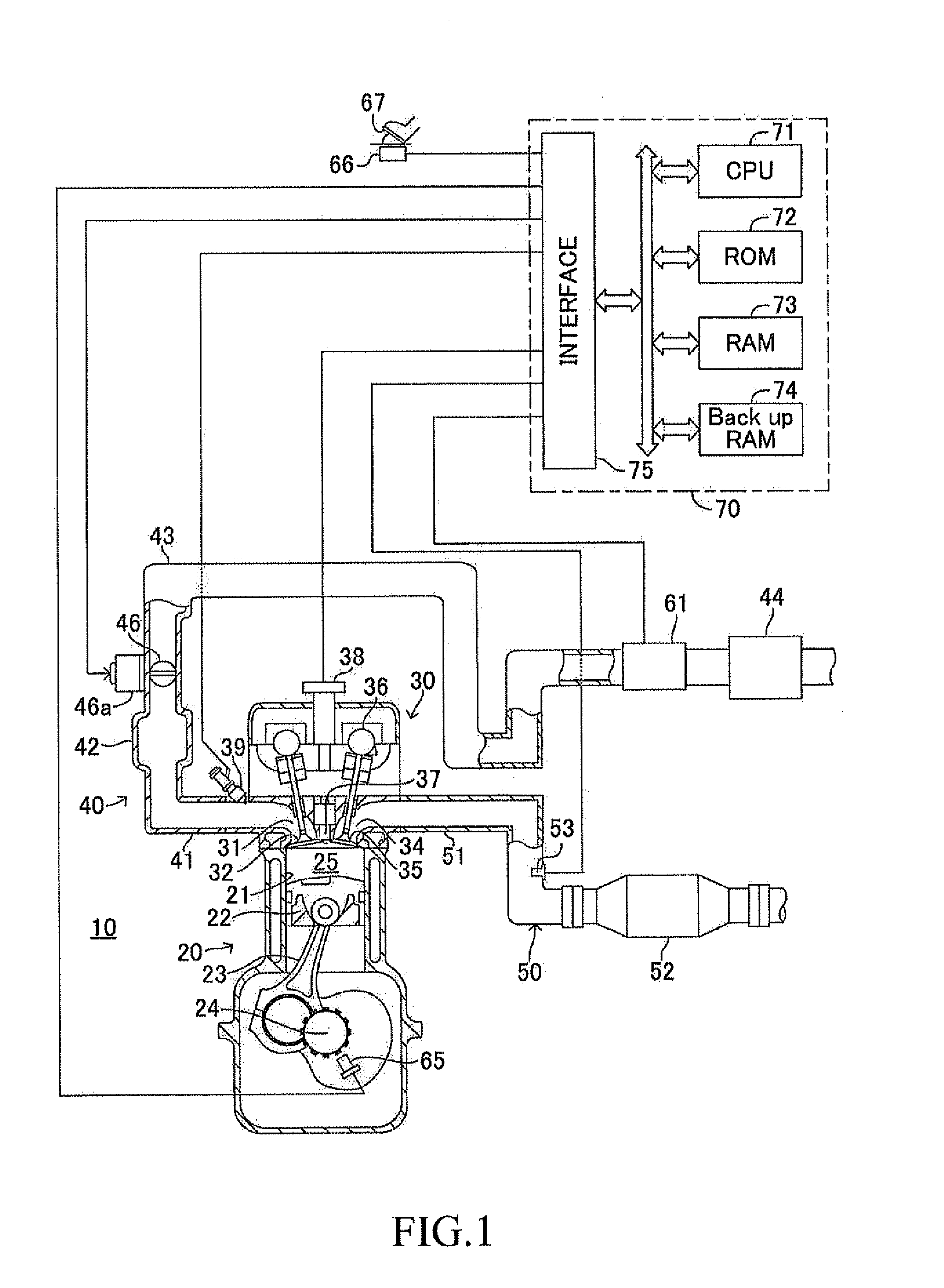Air-fuel ratio control apparatus for an internal combustion engine
a control apparatus and internal combustion engine technology, applied in the direction of electrical control, process and machine control, instruments, etc., can solve the problems of heat deterioration/degradation of the three-way catalyst, and achieve the effect of reducing the degree of leanness, reducing and increasing the temperature of the catalys
- Summary
- Abstract
- Description
- Claims
- Application Information
AI Technical Summary
Benefits of technology
Problems solved by technology
Method used
Image
Examples
first embodiment
[0052]Meanwhile, as described above, the three way catalyst 52 simultaneously can purify NOx, CO, and HC at high purification efficiency when the air / fuel ratio of the exhaust gas flowing thereto is close to the stoichiometric air / fuel ratio. Thus, the air / fuel ratio of the mixture formed in the combustion chamber 25 (the air / fuel ratio of the mixture formed in the combustion chamber is simply referred to as “air / fuel ratio of mixture” hereinafter) is preferably controlled to be the stoichiometric air / fuel ratio in terms of maintaining high purification efficiency in the three way catalyst. In view of the above, an ordinary stoichiometric control for controlling the air / fuel ratio of the mixture to be the stoichiometric air / fuel ratio is carried out when the engine operation state (operation state of internal combustion engine) is in an ordinary state according to this embodiment (referred to as a “first embodiment” hereinafter).
[0053]That is, a quantity of the air taken into the co...
second embodiment
[0100]In the temporary stoichiometric control when the air / fuel ratio of the mixture is richer than the stoichiometric air / fuel ratio serving as the target air / fuel ratio, the base fuel injection quantity calculated as described above is decreased by the decreased quantity correction amount which is decreased by multiplying the decreased quantity correction amount read from the map in (A) of FIG. 3 by the correction coefficients K1 and K2 read from the maps in (A) of FIG. 13 and (B) of FIG. 13, and the decreased base fuel injection quantity is set to the target fuel injection quantity.
[0101]Thereafter, the fuel injection valve is controlled in such a manner that a fuel of the target fuel injection quantity set in this way is injected from the fuel injection valve 39.
[0102]On the other hand, in the temporary stoichiometric control according to the second embodiment, when the air / fuel ratio of the mixture is leaner than the stoichiometric air / fuel ratio serving as the target air / fuel...
third embodiment
[0112]In the temporary stoichiometric control when the air / fuel ratio of the mixture is richer than the stoichiometric air / fuel ratio serving as the target air / fuel ratio, the base fuel injection quantity calculated as described above is decreased by the decreased quantity correction amount which is decreased by multiplying the decreased quantity correction amount read from the map in (A) of FIG. 3 by the correction coefficients K1 and K3 read from the maps in (A) of FIG. 15 and (B) of FIG. 15, and the decreased base fuel injection quantity is set to the target fuel injection quantity.
[0113]Thereafter, the fuel injection valve is controlled in such a manner that a fuel of the target fuel injection quantity set in this way is injected from the fuel injection valve 39.
[0114]On the other hand, in the temporary stoichiometric control according to the third embodiment, when the air / fuel ratio of the mixture is leaner than the stoichiometric air / fuel ratio serving as the target air / fuel ...
PUM
 Login to View More
Login to View More Abstract
Description
Claims
Application Information
 Login to View More
Login to View More - R&D
- Intellectual Property
- Life Sciences
- Materials
- Tech Scout
- Unparalleled Data Quality
- Higher Quality Content
- 60% Fewer Hallucinations
Browse by: Latest US Patents, China's latest patents, Technical Efficacy Thesaurus, Application Domain, Technology Topic, Popular Technical Reports.
© 2025 PatSnap. All rights reserved.Legal|Privacy policy|Modern Slavery Act Transparency Statement|Sitemap|About US| Contact US: help@patsnap.com



